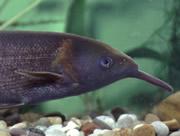 This 'nose' is pretty sophisticated.Gerhard von der Emde, University of Bonn
This 'nose' is pretty sophisticated.Gerhard von der Emde, University of BonnThe elephantnose fish, which finds its way at night using an electrical version of sonar, has sharp enough senses to assess the shape and size of objects in its tank in the dark, researchers have found. The fish can even identify shapes when they are present as simple wire frames rather than solid objects.
The sensing organ of Gnathonemus petersii (which looks, as the name suggests, like an elephant's nose) is actually an elongated chin packed with electrical sensors that detect distortions in the fish's own electric field. As it hunts for food in the pitch darkness of a tropical central African night, the elephantnose fish sweeps its snout over the ground like a person using a metal detector, to navigate around obstacles and locate the larvae it feeds on.
During daylight hours, most fish can use their eyes to form a sophisticated picture of the size and shape of objects around them. But no one knew whether elephantnose fish could do the same using their electrolocation.
In the dark
To find out, Gerhard von der Emde and his colleagues at the University of Bonn, Germany, put a cube and a pyramid in the tank and studied the fishes' navigation in complete darkness, while watching with an infrared camera. Each time a fish swam to the pyramid it received a worm as a reward.
The fish easily learnt to pick out the pyramid. Von der Emde puts this ability down to the fact that African elephantnose fish have the biggest brains, relative to body length, of any fish (in fact, this proportion is higher than it is in humans too), and they are known to have good memories. His champion fish, trained for 3 years, was able to remember which object to choose after a break of a few months.
When solid objects were swapped for hollow wire models, the fish could still spot the pyramid, suggesting that they can form an impression of a shape just from its outline. If the pyramid wasn't among the offered objects, the fish tended to swim for the object with the closest match in terms of volume, they report in the Journal of Experimental Biology1.
"It's very impressive how detailed their view of the environment is," says Von der Emde.
Sophisticated fish
Von der Emde says this remarkable performance in complex object-recognition tasks shows that elephantnose fish can build up sophisticated three-dimensional images of their surroundings from electrical signals. "The electric sense lights up the night," for these clever fish, he says.
ADVERTISEMENT
John Lewis, professor of zoology at Royal Holloway, University of London, agrees that the African elephantnose is "brighter" than your average fish, and isn't surprised to hear that they have sophisticated methods for navigation.
So admirable is the electrolocation system in these fish that other researchers are now trying to mimic it with artificial electric-field-sensing technology, which could give robot submersibles the same type of night vision.
Visit our throughthe_chin.html">newsblog to read and post comments about this story.
